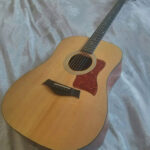Learning to play guitar can be incredibly rewarding, and tackling popular songs is a fantastic way to start. If you’re looking for an iconic song with beginner-friendly chords, “Wonderwall” by Oasis is an excellent choice. This guide will walk you through the essential “Wonderwall” guitar chords and strumming techniques to get you playing this classic tune in no time.
The beauty of “Wonderwall” lies in its simplicity. It primarily uses a sequence of open chords that are foundational for any aspiring guitarist. These chords are: Em (E minor), G (G major), D (D major), and A7 (A dominant 7th), and C (C major). Each of these chords is relatively easy to learn and finger, making “Wonderwall” accessible even if you’re just starting your guitar journey.
Once you’re comfortable with the chord shapes, the next step is mastering the strumming pattern. While there are various ways to strum “Wonderwall,” a fundamental pattern to begin with involves downstrokes and upstrokes. Focus on keeping a consistent rhythm and using your elbow as the primary source of motion for strumming. Avoid excessive wrist movement initially; instead, let your elbow guide your strumming arm for a smoother and more relaxed sound. Concentrate on making your downstrokes consistent and allow the upstrokes to occur naturally as a return motion, ready for the next downstroke. Consistency in your strumming speed is also key. Try practicing with a metronome or a simple drum beat to develop a steady tempo right from the start. Beginning slowly and gradually increasing speed as you become more comfortable is a proven method for learning new strumming patterns effectively.
For beginner guitarists, thumb placement can also be a point of focus. Be mindful of your thumb position on the guitar neck. Avoid wrapping your thumb too far over the top of the neck, as this can sometimes lead to unintentionally muting or fretting the low E string. Instead, try positioning your thumb more towards the back of the neck. Muting the low E string, when necessary, can be achieved with just the side of your thumb, without needing to wrap it over excessively. This adjustment can help ensure cleaner chord sounds and prevent unwanted string buzzing.
In conclusion, “Wonderwall” guitar chords are a perfect starting point for new guitar players. By learning the Em, G, D, A7, and C chords and practicing a consistent strumming pattern with an emphasis on elbow movement and mindful thumb placement, you’ll be well on your way to playing this timeless song. Remember to start slow, focus on consistency, and enjoy the process of learning.

